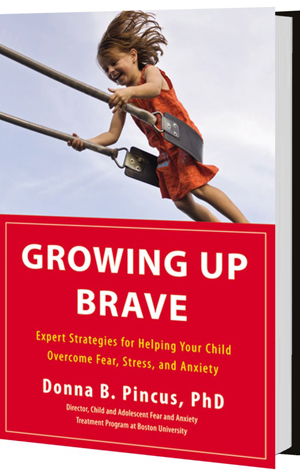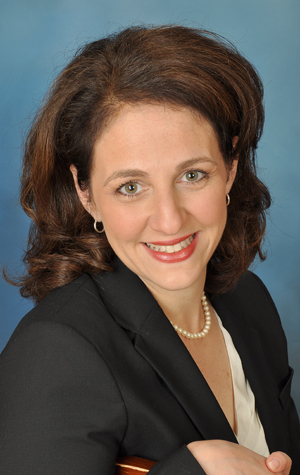When the World Is Scarier Than It Should Be
CAS prof’s book: hope, advice on easing childhood anxiety

For years, as she shared wisdom gained from treating childhood anxiety disorders, colleagues urged Donna Pincus to write a book. Released last month, that book, Growing Up Brave: Expert Strategies for Helping Your Child Overcome Fear, Stress, and Anxiety (Little, Brown and Company, 2012), Pincus, director of research for the Child and Adolescent Fear and Anxiety Treatment Program at BU’s Center for Anxiety and Related Disorders, walks readers through techniques to reduce or eliminate childhood anxiety.
The book, which weaves science and anecdotes into an enlightening guide for parents, teachers, and health care workers, offers a readable counterpoint to the many less informed prescriptions kicking around on the internet. A College of Arts & Sciences associate professor of psychology, Pincus is currently principal investigator of a study funded by the National Institute of Mental Health to develop a treatment for young children with separation anxiety disorder. She gives numerous talks and workshops on child anxiety, which affects one in eight children, according to the Anxiety Disorders Association of America.
BU Today talked with Pincus about why childhood anxiety is such a big problem and why her advice and observations could benefit all parents.
BU Today: Will most parents who read this book recognize themselves in it?
Pincus: Parents will likely relate to the many difficult situations we are all regularly faced with—for example, knowing when to follow our so-called instincts to protect and when to take a step back and allow a child room to navigate certain challenges on his or her own. Most parents have faced this challenge of knowing how to strike the best balance. Numerous parents have related that they recognized themselves in the chapter on parent-child interaction styles that affect anxiety—and that their awareness of these parenting styles was the first step in modifying the ways they interact with their children.
Children have always endured hardship and stress. Do you believe childhood stress and anxiety is on the rise, and if so, why now?
Throughout history we have always faced stressors—from polio to wars to current day terrorism. Although stressors have always been present, our awareness and understanding of stress, anxiety, and its effects on children have improved, as have our diagnostic practices. Thus, it is unclear whether rising rates of child anxiety disorders reflect our better identification of these disorders or an actual shift in their occurrence. Given that we currently have more routes through which the news can reach children—television, the internet, mobile devices—children today may be receiving a more constant stream of information telling them the world is dangerous, thus focusing their attention on their lack of control over their environment.
What is the likely effect on a child when adults dismiss fears by saying, “That’s silly” or “Be a big boy”?
Sometimes parents respond to children that way because they are unsure how to help. But these statements minimize children’s feelings and shut down important opportunities for communication about why the child is afraid. Parents may use these statements with the intention of getting kids to know that there is nothing to worry about, but there are much more helpful and effective ways to help children learn this.
Can you describe one or two important coping skills you recommend for fearful or anxious children?
One important skill is to teach a child to understand the cycle of anxiety and how to break down anxious feelings into thoughts, feelings, and behaviors. This helps give kids an appreciation for when anxious feelings are normal, how anxious feelings can become interfering, and how they can use tools to, as we put it, break the cycle. Another important skill is to develop a Bravery Ladder, which essentially is creating a hierarchy of situations, in order from easiest to hardest, that the child has previously avoided. The child then learns how to begin to enter these situations to retrain their brains to not experience fear. Essentially we help children understand on a basic level the concept of why exposure therapy works to make kids feel less afraid.
It seems when parents rely on their instincts, often the problem gets worse. In what ways might common sense fail to help anxious or fearful children, and why?
Parents’ instincts are shaped by many factors, including their previous experience—so, for example, if a parent is anxious, his or her instinct might be to prevent a child from entering an age-appropriate situation or to overprotect a child from a new challenge. As a result, children may lose out on important opportunities for developing new coping skills and gaining self-confidence.
You write about age-appropriate fears—can you give a few examples parents need not be overly concerned about?
Fears of strangers in infancy, fears of monsters or fears of the dark during the preschool years, as well as many other specific fears, such as of spiders or of costumed characters—most of these arise at predictable stages in development, are adaptive, and tend to dissipate naturally as children get older without necessarily requiring any intervention.

What are the implications of the interaction of genes and experience in helping children suffering from anxiety and phobias?
Investigators are researching the genetic markers that are associated with treatment outcome in children with anxiety disorders. Children with a specific genetic marker, for example, may be more responsive to our cognitive behavioral treatments than those without this marker. Research on the interaction of genes and experience underscores the importance of creating early environments that teach children effective ways of regulating their emotions, and provide children with early experiences of control and security. Even if the genetic vulnerability is there, the right environment may even prevent these genes from being expressed.
What are your feelings about medicating anxious children?
Given the tremendous amount of empirical support for cognitive behavioral interventions for child anxiety disorders, it is best to start with a course of cognitive behavioral treatment and to consider medication if a child has not responded to therapy. Although some clinical trials do show benefits of medications as well as therapy, medications are often accompanied by unwanted side effects, and the rush to medicate is in most cases unnecessary
Should parents try to conceal their own worries from young children?
It is important for parents to remember that they are models for their children on how to perceive the world and how to react to situations. It is important to help young children feel a sense of security and safety; thus, it is best to not discuss adult issues or worries with young children who are likely not cognitively equipped to understand these concerns. Though stressors do inevitably occur in life, and sometimes even young children pick up on parents’ worries, it is best to model healthy ways of coping with these stressors.
Is it a good idea to shield children from sad or frightening events in the news?
Parents should try to limit kids’ exposure to frightening news events. This has become more difficult to do given the many streams of information available to children through the internet, television, mobile devices, radio, peers, and other parents. Parents can teach older kids about the differences between the possibility and probability of a negative event occurring, which helps reassure them that they are safe. For very young children, unless the child brings it up, it is usually unnecessary to discuss frightening news events with them. Rather, it is healthier to help children to keep their focus in the moment rather than on anxiety about the future.
When it comes to fears and anxieties, how much influence do children, siblings or playmates, have on one another?
Siblings and peers are important and influential models for each other. For example, peers and siblings can model the use of good coping or problem-solving skills and can have a positive influence on one another, but they can also transfer their fears to one another and model unhealthy emotional responses to stress.
Your book has some fascinating examples of children who develop rituals to cope with stressful situations. When should parents be concerned?
When rituals are taking up excessive amounts of time, are interfering with a child’s normal functioning—for example, when falling asleep is disturbed by repeated, excessive checking of door or window locks—and when a child cannot stop the rituals despite attempts and a desire to stop, these are all red flags indicating that there is a need for parents to seek professional attention.
Can you explain how child-directed interaction works to help reduce anxiety?
In child-directed interaction, which is one component of the empirically supported treatment parent child interaction therapy, parents learn specialized skills to use during a five-minute-a-day playtime that helps them to interact with their child in a way that reinforces a secure attachment, increases warmth, and improves parent-child interactions. I think these skills could be beneficial for most any parent.
What is the most important message of Growing Up Brave?
I want to communicate the hopeful message that there are many strategies parents, teachers, clinicians, and other health care professionals can use to help children learn to cope effectively with stress and anxiety, and that cognitive behavioral treatments should be the frontline treatment of choice for helping children with anxiety disorders quickly return to normal functioning. Research on anxiety disorders in childhood and their effective evidence-based treatments have grown tremendously in recent years, and in Growing Up Brave I have tried to translate this knowledge to the public.
Comments & Discussion
Boston University moderates comments to facilitate an informed, substantive, civil conversation. Abusive, profane, self-promotional, misleading, incoherent or off-topic comments will be rejected. Moderators are staffed during regular business hours (EST) and can only accept comments written in English. Statistics or facts must include a citation or a link to the citation.